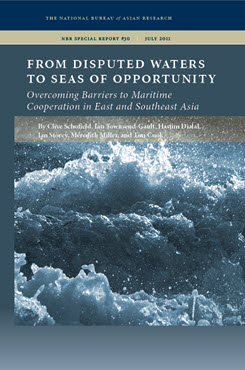NBR Special Report no. 30
From Disputed Waters to Seas of Opportunity
Overcoming Barriers to Maritime Cooperation in East and Southeast Asia
This report highlights findings from the National Bureau of Asian Research’s three-year project “Maritime Energy Resources in Asia: Opportunities for Joint Development,” which assesses maritime jurisdictional disputes and opportunities for cooperation in East and Southeast Asia.
EXECUTIVE SUMMARY
MAIN ARGUMENT
Long-standing disputes over maritime jurisdictional claims in the East China Sea, South China Sea, and Gulf of Thailand threaten the long-term stability and prosperity of states in East and Southeast Asia. Despite numerous multilateral efforts in recent decades and international legal regimes such as the UN Convention on the Law of the Sea, tensions among claimant states and user states remain high. Resolution of these disputes has eluded the claimant states, given the complexity of the domestic political, historic, legal, economic, and strategic factors involved and the pressure to develop the estimated vast energy resources in the disputed areas. Concerns over resource access, coupled with the claimant states’ failure to implement confidence-building measures (CBM) to ease tensions, demonstrate that political resolution is unlikely in the near term. In the absence of a long-term agreement, claimant states must take concerted interim actions to ease tensions, foster cooperation and trust, and maintain joint stewardship of the environment and marine resources.
POLICY IMPLICATIONS
- States can better manage current tensions by implementing CBMs, including those outlined in the Declaration on the Conduct of Parties in the South China Sea (DoC). These could include the use of telephone hotlines, advance notification of military exercises, joint search and rescue capabilities, cooperation on countering transnational threats, rules of conduct for engagement on the high seas, and increased military transparency.
- Notwithstanding the lack of progress in implementing the DoC, China and the ASEAN states should begin negotiations on a code of conduct for the South China Sea that would formalize CBMs and reduce destabilizing actions.
- Interim management of the multiple interconnected territorial and maritime disputes in Asia’s waters is the best way to ensure the freedom of navigation and free flow of trade that is critical to the regional and global economies. Such arrangements need not prejudice states’ maritime claims in the near term.


